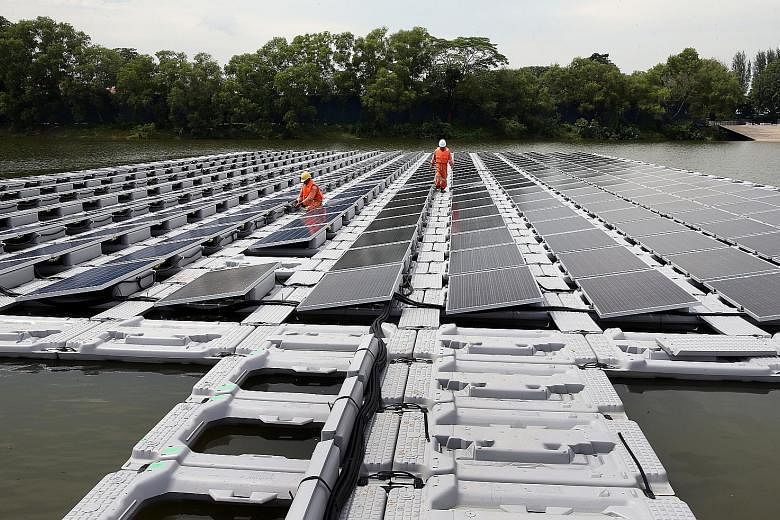BANGKOK • Solar power companies in South-east Asia that are competing for land with agriculture, industry and expanding populations have found an innovative alternative - to put floating panels in lakes, dams, reservoirs and the sea.
Earlier this week, state utility Electricity Generating Authority of Thailand (Egat) said it would submit a proposal for a 45MW floating solar plant in the Sirindhorn dam in the country's north-east.
Egat plans to invest in about 16 such projects across nine dams in the country, deputy governor Thepparat Theppitak told reporters.
Elsewhere in the region, Singapore is developing one of the world's largest offshore floating solar systems in the Strait of Johor to the north of the island.
"In land-scarce countries like Singapore, the widespread use of PV (photovoltaic) systems is hindered by space constraints and limited roof space," said Mr Frank Phuan, chief executive of Sunseap Group, which is building the system.
The platform has to be "more robust" than systems in reservoirs or lakes to withstand tougher conditions on the open sea, and to overcome barnacles that may grow on it, he added.
It was also difficult to find a spot in the sea that was not frequented by shipping vessels, he said.
The project, which is supported by Singapore's Economic Development Board, will be located north of the Woodlands Waterfront Park.
Despite the challenges, floating solar systems are growing quickly in Asia alongside those on the ground and on roofs, according to the Solar Energy Research Institute of Singapore (Seris).
While floating panels are more expensive to install, they are up to 16 per cent more efficient because the water's cooling effect helps reduce thermal losses and extend their life, according to Seris.
The panels also reduce evaporation from water bodies when temperatures are warm, thus saving fresh water for drinking.
"The greater efficiency offsets the higher cost of installation," said Seris senior financial analyst Celine Paton. "Technological advances should soon bring them on a par with ground systems" in terms of cost, she told the Thomson Reuters Foundation.
South-east Asia is particularly well suited for floating panels because of the scarcity of land and because they can be easily installed in the region's many hydropower dams, where they can use existing transmission systems, she added.
On the whole, the growing clean energy sector, including solar generation, can be a boost for the economy. New investments in Singapore's clean energy industry, for instance, will generate $180 million in annual business spending and create about 1,000 professional jobs in the next five years, Singapore's Minister for the Environment and Water Resources Masagos Zulkifli said last November.
China currently accounts for most of the more than 1.1 gigawatts of floating solar capacity now installed, according to the World Bank. Meanwhile, India recently announced a plan to develop 10 gigawatts of floating solar capacity.
The technology's potential is about 400 gigawatts, or about as much generating capacity as all the solar photovoltaic panels installed in the world through 2017, the World Bank said.
There are concerns that the panels could block sunlight, affecting marine life, and that the electrical systems might not withstand the onslaught of water.
But backers say the technology is proven, and that the panels cover too small a surface area to create major problems.
REUTERS, THE STRAITS TIMES

